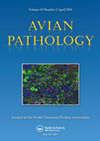野鸟源轮状病毒A株在家鸡中的传染性和致病性。
IF 2.2
2区 农林科学
Q1 VETERINARY SCIENCES
引用次数: 0
摘要
研究重点:本研究进行了鸡感染轮状病毒A (RVA)的实验。两种野鸟源性RVA菌株(RK1和PO-13)可引起雏鸡腹泻。这些菌株的肠致病性与鸡菌株相当。研究结果表明,家禽业存在野生鸟类来源的rva风险。本文章由计算机程序翻译,如有差异,请以英文原文为准。
Infectivity and pathogenicity of wild bird-derived rotavirus A strains in domestic chickens.
Research highlights: This study conducted an experiment on chicken infection with rotavirus A (RVA) strains.Two wild bird-derived RVA strains (RK1 and PO-13) caused diarrhoea in young chickens.The enteropathogenicity of these strains was comparable to that of a chicken strain.The findings indicate the risk of wild bird-derived RVAs in the poultry industry.
求助全文
通过发布文献求助,成功后即可免费获取论文全文。
去求助
来源期刊

Avian Pathology
农林科学-兽医学
CiteScore
4.50
自引率
10.70%
发文量
68
审稿时长
1 months
期刊介绍:
Avian Pathology is the official journal of the World Veterinary Poultry Association and, since its first publication in 1972, has been a leading international journal for poultry disease scientists. It publishes material relevant to the entire field of infectious and non-infectious diseases of poultry and other birds. Accepted manuscripts will contribute novel data of interest to an international readership and will add significantly to knowledge and understanding of diseases, old or new. Subject areas include pathology, diagnosis, detection and characterisation of pathogens, infections of possible zoonotic importance, epidemiology, innate and immune responses, vaccines, gene sequences, genetics in relation to disease and physiological and biochemical changes in response to disease. First and subsequent reports of well-recognized diseases within a country are not acceptable unless they also include substantial new information about the disease or pathogen. Manuscripts on wild or pet birds should describe disease or pathogens in a significant number of birds, recognizing/suggesting serious potential impact on that species or that the disease or pathogen is of demonstrable relevance to poultry. Manuscripts on food-borne microorganisms acquired during or after processing, and those that catalogue the occurrence or properties of microorganisms, are unlikely to be considered for publication in the absence of data linking them to avian disease.
 求助内容:
求助内容: 应助结果提醒方式:
应助结果提醒方式:


